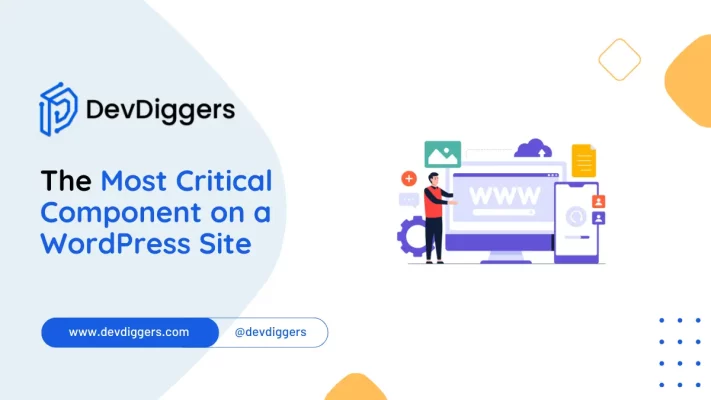The Most Critical Component of a WordPress Site

When building a successful website on WordPress, it’s easy to get lost in the multitude of options, from design and functionality to content creation.
However, at the core of every effective WordPress site lies a singular critical component that often determines its success or failure.
While each website’s needs may differ, the most critical component of a WordPress site is undoubtedly its content.
WordPress is one of the most powerful and flexible CMS platforms. It gives you all the tools you need to create a well-functioning website, but mastering the key elements of the CMS is crucial for long-term success.
Let’s explain why this component is essential and how you can maximize its potential.
Table of Contents
Why The Most Critical Component of a WordPress Site is Content

It might be good to ask, but isn’t design equally important? Or What about speed and security? The important thing is that these elements are, in their own right, important.
But they all serve only to make the content better and get it to the audience. Here’s why it should lead the pack:
1. Content Drives Traffic
Search engines like Google exist on content they crawl, index, and rank them. The quality and relevance of the content you serve your readers will improve their minds and entice search engines to route more traffic to your site.
This is where keyword optimization, captivating headlines, and detailed articles come into play.
2. Content Enhances User Engagement
Just imagine hitting a website with fabulous design but empty or low-content information. Painful, right? Content is what keeps visitors hanging out on your site, encourages them to explore further, and even spurs action.
Engaging content fosters a connection with your audience, leading to longer visits and higher conversion rates.
3. Content Builds Credibility and Authority
Content is a wonderful tool to build credibility in the digital space. Well-researched, insightful, and well-written content establishes you as a key thought leader in your field.
It generates trust with your audience, who eventually become loyal followers or customers.
4. Content Supports SEO Efforts
When discussing Search Engine Optimization (SEO), we mean driving organic traffic. Quality content with relevant keywords, internal links, and valuable information improves your SEO effort. Moreover, fresh content signals search engines that your site is active and up to date.
5. Content Influences User Experience (UX)
Success for a website comes through user experience. Content will be a relative factor to UX because the information users are trying to find will be presented through it and guide them along the journey on your site.
Hence, well-structured, easily navigable content will make the user do things more quickly, thus upping the overall experience and satisfaction.
Crafting Content That Shines

Now that we’ve established why content is crucial, let’s delve into how you can create content that stands out and makes a lasting impact. Here are some tips to help you get started:
1. Understand Your Audience
Once you have decided what to write, be sure to take some time to understand who your readers are and what they are searching for.
What are their pain points, interests, or preferences? This will allow you to make content relevant to their needs and, hence, more engaging.
2. Create Valuable and Original Content
Originality is the word. Not that you must plagiarize and allow some guy to formulate and convey his thoughts.
Whatever idea it is, ensure your content gives a different look or solution to the receivers. This could be through in-depth guides, insights-creating blog posts, or entertaining videos, your content should bring something new to the table for your audience.
3. Craft Catchy Headlines
The very first thing you are going to be reading is your headline. Therefore, use it to make a White great.
An interesting headline will promise a reader that he or she would like to find out more. Big words, absolute clarity, and sometimes numbers or questions can take content on some amazing leaps.
4. Use Visuals Wisely
A picture is said to speak a thousand words, especially in the world of cyberspace. Incorporate high-quality images, infographics, and videos to support your content and bring it to life.
Visuals break up text, help illustrate points, and bring attention to your article.
5. Optimize for Readability
Most people skim content, so keeping your text easy on the eyes does a lot. Short paragraphs, bullet points, and subheadings break up text for both eyes and add interesting visuals.
A conversational tone also helps to keep content more relatable and easier to digest.
6. Include Calls to Action
Every piece of content has a very clear call to action, which might be asking the visitors to subscribe to your newsletter to get some free resources, or even buy from you. Make the CTA prominent and persuasive.
Keeping Your Content Fresh and Engaging

Content creation isn’t a one-time task. To keep your WordPress site relevant and engaging, you need to continually update and refresh your content. Here’s how:
1. Regular Updates
Keep your content current by regularly updating posts with new information or insights. This not only helps with SEO but also shows your audience that you’re active and knowledgeable.
2. Repurpose Content
Maximize the value of your existing content by repurposing it. Turn a blog post into an infographic, a series of social media posts, or a video. This allows you to reach different segments of your audience in various formats.
3. Engage with Your Audience
Encourage interaction by responding to comments, asking for feedback, and engaging with your audience on social media.
This not only fosters a sense of community but also provides valuable insights into what your readers want.
4. Monitor Content Performance
Regularly review analytics to understand how your content is performing. Look at metrics such as page views, time on page, and bounce rates to gauge what’s resonating with your audience.
Use this data to refine your content strategy, focusing on what works and adjusting what doesn’t.
5. Update Old Content with New Information
Identify older posts that are still relevant but may need updates. Refresh these posts with new statistics, updated information, or additional insights.
This not only improves the accuracy of your content but also helps maintain its relevance and usefulness.
Conclusion
In the grand scheme of WordPress site components, content truly is king. It drives traffic, enhances user engagement, builds credibility, and supports your SEO efforts.
By focusing on creating valuable, engaging, and optimized content, you’ll set yourself up for success and keep your audience coming back for more.
So, are you ready to take your WordPress site to the next level? Start by honing your content strategy and watch as your site transforms into a powerhouse of information and engagement.
Call to Action
If you found this guide helpful, don’t keep it to yourself! Share it with your friends and colleagues who might benefit from these insights.
If you’re looking for more tips and tricks on making the most of your WordPress site, subscribe to our newsletter or drop us a comment below. We’d love to hear from you!
FAQs
What makes content the most critical component of a WordPress site?
Content is the most critical component of a WordPress site because it drives traffic, enhances user engagement, and supports SEO efforts. High-quality, relevant content provides value to your audience and helps search engines rank your site higher, ultimately leading to more visitors and better user interaction.
How often should I update my content to keep it fresh?
To keep your content fresh, aim to update it regularly—at least once every few months. Regular updates can include adding new information, refreshing statistics, or revising outdated content. Additionally, updating older posts with current insights can boost their relevance and performance.
What are some effective strategies for repurposing content?
Effective strategies for repurposing content include transforming blog posts into infographics, videos, or social media posts. You can also create a series of related posts from a single comprehensive article, or turn a popular post into a downloadable e-book. Repurposing helps reach different segments of your audience and extends the lifespan of your content.
How can I measure the effectiveness of my content?
You can measure the effectiveness of your content by monitoring key metrics such as page views, time on page, bounce rate, and conversion rates using tools like Google Analytics. Additionally, track engagement metrics like social shares, comments, and backlinks to gauge how well your content resonates with your audience.
What are some tips for creating content that engages users?
To create engaging content, focus on providing value, using a conversational tone, and addressing your audience’s needs and interests. Incorporate visuals like images and infographics, use compelling headlines, and include clear calls to action. Encouraging interaction through comments and social media can also boost engagement and build a sense of community.
